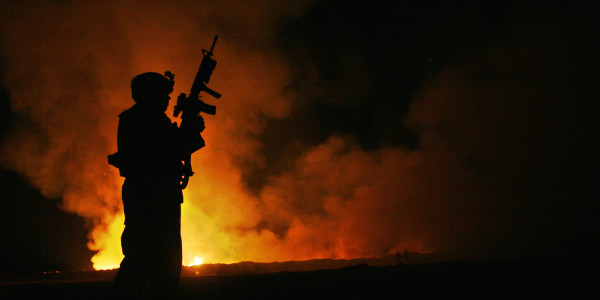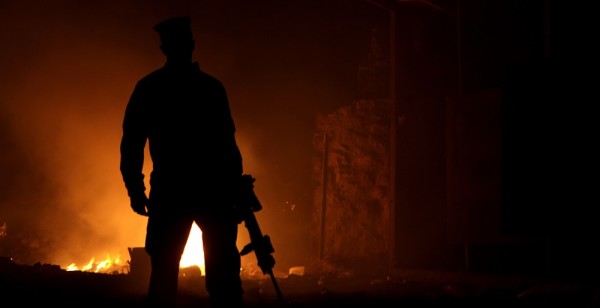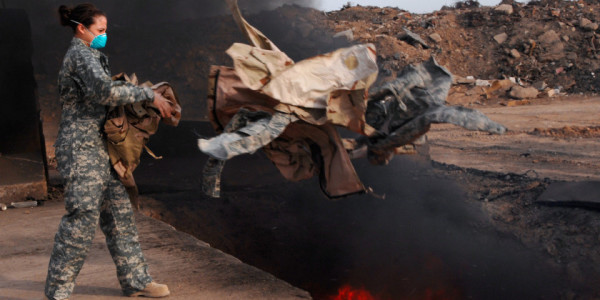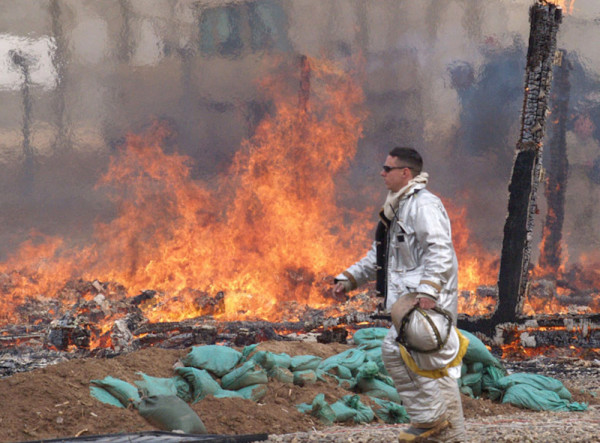For years, images of service members heaving military waste into smoldering craters have been paired with stories about burn pits and illness. This repetitive combination of words and pictures inadvertently misleads the public, veterans, and service members to believe that chronic illnesses and terminal cancers are solely caused by burn pit exposure in combat zones.
There is no doubt that inhaling these acrid fumes is dangerous, but “burn pits” are only a small fraction of the exposures to toxins our military service members face. This misinformation hinders the conversation about toxic exposure and, worse, confuses those that have served regarding their potential exposures and related health risks. Here is the reality:
Burn pits are not the exclusive source of military toxic exposures. Inhalation exposures are not the only route of exposure. Deploying to a combat zone is not a requisite for exposure to toxins.

During one’s military career, regardless of time, grade, or job specificity, a service member will inevitably experience multiple exposures to various toxic substances (fuel, chemical, exhaust, ammunition, explosives, etc), and these exposures impact the human body in a multifactorial way. The specificity and volume are dictated by military occupational specialty and time in service, but servicemembers will ultimately be exposed to toxins whether they are turning wrenches in a motor pool or kicking doors in a combat zone. The risk of exposure is inherent to military service and accepted within the culture of perseverance and (i.e., chronic stress, inadequate sleep, environmental conditions), but understanding the sporadic nature of toxic exposure and its impact will help to proactively identify and mitigate risk. Normalizing this practice is essential for optimal wellness and health longevity of the servicemember.
Understanding the root cause of any problem is the first step in creating a practical, viable solution. But when the root cause is incorrectly identified or assumed, it prevents people from making informed decisions about their healthcare. Advocacy for one cause of illness without proper attention to other prevalent causes is willful blindness, and that kind of tunnel vision has no place in medicine. Point blank: believing “burn pits” are the singular cause of exposure-related illnesses is a roadblock in improving warfighter health.
If we continue on this path, we will end up behind the curve, like when healthcare providers misdiagnose Traumatic Brain Injuries (TBI) as Post-Traumatic Stress Disorder (PTSD). Studies of post-9/11 veterans found that 59% had met the diagnostic criteria for post-traumatic stress disorder through the self-assessment PCL-5. However, after a structured clinical interview, only 3% of the veteran patients actually had post-traumatic stress. Researchers found that many of the TBI patients failed to follow the questionnaire instructions and erroneously endorsed PTSD symptoms because of their cognitive difficulties relating to traumatic brain injury. There is rarely a catch-all treatment or miracle drug for any condition, so administering the wrong one has counterproductive effects on health and recovery.
HunterSeven Foundation, a nonprofit focused on military toxic exposure research and education, recently conducted a scientific study with over 3,000 respondents who had deployed to Afghanistan at least once between 2001 and 2018. The study revealed the following:
- 36% of respondents reported being directly involved with an IED blast
- 75% of respondents reported having some IED-related exposure
- 51% of respondents reported unexploded ordnance exposures
- 41% of respondents reported active chemical exposures (mostly to the skin)
- 19% of respondents reported being exposed to Depleted Uranium
- 18% of respondents reported exposure to asbestos
- 13% of respondents reported exposure to radiation
- 79% of respondents reported burn pit exposures on base
Still, this study only reflects known exposures; many don’t know they were exposed to toxins off base. Consider the poor air quality, small particulate matter, and contaminated water sources that service members were exposed to in the austere environments of Afghanistan and Iraq. These off-base exposures are environmental in nature and cause severe health conditions.

Suppose a service member complains of severe, worsening headaches, and vision loss. In that case, the immediate assumption is “burn pits,” without investigation into any other toxic exposures they have experienced in their career. This generalization appears to stem from incomplete media coverage of toxic exposures. But what is worse, total absence or inadequate coverage? Focus on burn pits provided a false plateau and encouraged tunnel vision in the fight against toxic exposure.
Carcinogen-related conditions gained massive press in the wake of legislation that stood to leave 9/11 first responders without care. The attention was well deserved and needed for a specific group but also drew a shortsighted correlation that service members were experiencing the same things. Burn pits are presumed to be the culprit instead of repeated brain injuries from exposure to blasts or any other host of injuries or exposures regularly endured by servicemembers. This assumption can be devastating for the individual as it can hinder proper diagnosis and preventative treatment.
Bottom line: The dialogue around toxic exposure should be evidence-based, relevant, solution-focused, and preventative. Recalibrating the conversation to be proactive and precautionary is vital to helping veterans understand their health.
When headlines read “Burn pits are the Agent Orange for post-9/11 veterans” or “Burn pits are making people sick,” it creates a sense of false closure and hopelessness. After watching things like Agent Orange pan out over half a century, the message is, “this is how we will live and die, and there is nothing to be done.”
The information crucial to positively impact change needs to be supported with evidence-based facts, medically sound research, and a proactive tone. This is not currently being done within mainstream media and communications related to toxic exposures, vilifying the topic of toxic exposures.
Changing the conversation around toxic exposures is a large-scale effort, as this topic is overshadowed by the repetitive discussion about burn pits, compensation, and legislation. The truth is that VA compensation will not save veterans’ lives; understanding toxic exposure and advocating for preventative practices and treatments will. Awareness and education are the fuel to drive change and transform the discussion about toxic exposures and ultimately the health and medical care needed.
+++
Keith Walter Dow is a U.S. Army veteran from New England where he is studying to receive his Master of Social Work. His newest book, Karmic Purgatory is available now and his other work has been published in Fact & Memory, In Love &…War: The Anthology of Poet Warriors, and Coffee or Die Magazine. He is the Director of Outreach and Coordination at HunterSeven Foundation and the Co-Founder of Dead Reckoning Collective, a publishing company exclusively working with military veterans to share their stories in all written genres.
More great stories on Task & Purpose
- It’s official: Marine Corps brings back the sleeve tattoo
- Air Force says colonel who berated subordinates in leaked audio created ‘unhealthy’ climate
- The difference between Air Force and Navy pilots in one short video
- We finally know why the Army fired its three-star general in charge of housing
- This is the Army’s plan to stop physically breaking so many of its soldiers
- The Army is reviewing its height and weight standards for the first time in decades
- Air Force uniform that covered sleeping Afghan child in evacuation photo headed to a museum
Want to write for Task & Purpose? Learn more here and be sure to check out more great stories on our homepage.








